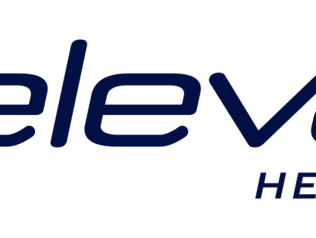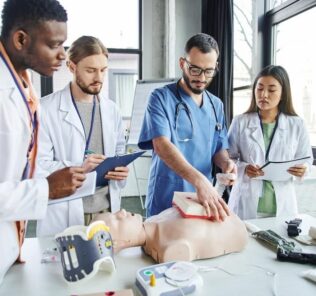Top 25 Healthcare Simulation Articles of 2022
Last year, HealthySimulation.com published hundreds of healthcare simulation articles to help keep simulation educators and learners across the globe informed on the current state of the industry. These clinical simulation articles shared insights, trends, product information, and much more. The ultimate goal is that readers worldwide are able to use this information and strengthen their own understanding of medical simulation, and incorporate what they’ve learned into their respective clinical simulation programs, curriculums, facilities, etc. This HealthySimulation.com article highlights the top 25 healthcare simulation articles of 2022.
25. Release of Meta Quest Pro Supported by Healthcare Simulation VR: The Meta Quest Pro is Meta’s most advanced headset yet and establishes a new way for users to work, create, and collaborate. The technology allows simulationists to utilize the virtual world with breakthrough high-resolution mixed reality through which they can engage effortlessly while maintaining their presence in the physical space in hi-def color. The release of the Meta Quest Pro has been supported by several healthcare simulation companies who announced they will utilize the technology to enhance their own product experiences. This HealthySimulation.com article shares more about the Meta Quest Pro and details on which clinical simulation companies offer supportive products.
24. Leveling Up on Prelicensure Learners Telehealth Healthcare Simulations: Clinical simulation education and training have proven to greatly increase patient safety across medical treatment facilities. For this to happen, prelicensure baccalaureate nursing learners must receive skills training and competency check-offs to ensure adequate care of patients as they continue through the curricula. To certify that these skills are met, nursing learners are typically evaluated based on the National League of Nursing (NLN) and/or QSEN competencies at clinical sites. Much of their learning is reinforced through healthcare simulation-based experiences (SBEs), nursing simulation-based experiences may focus on a variety of topics and actions such as interventions, skills, and therapeutic communication.
Sponsored Content:
23. A Quick Guide to Birthing Simulators & OBGYN Simulation: Healthcare simulation as a whole is mainly about teaching the practice of medicine to achieve heightened patient safety. One of the areas of medical simulation that has yielded some of the most dramatic arguments in favor of promoting clinical simulation across education is Obstetrics and Gynecological-based simulation. The practice of simulated care for both mother and child up to and after the birthing process goes back to the 1600s. Obstetrics and Gynecological (OBGYN) simulation is a pillar of healthcare simulation, and the market has been and always will always be perplexing. This HealthySimulation.com article by Kirk Atkinson, a Simulation Operations Specialist at UT Southwestern, discusses the different types of OBGYN-based simulators available and shares a quick guide approach to purchasing the proper simulator for each respective healthcare simulation program.
22. WISER TechSim Course Aims to Improve Sim Center Operations & Efficiency: Healthcare simulation centers often seek training programs designed to educate Simulation Operations Specialists on the key tasks associated with daily operations and maintenance. These tasks are vital to the overall operation of the clinical simulation center, and to the success of learner experiences. To provide such a program, the Winter Institute for Simulation, Education, and Research (WISER) developed the TechSim course series. TechSim Online and TechSim Onsite offer simulation specialist Continuing Professional Development (CPD) credits toward re-certification of their CHSOS and CHSOS-A. This HealthySimulation.com article shares more about these courses, what materials are covered, and how medical simulation learners can enroll.
21. Sentinel U Launches Virtual Simulation Advanced Practice Series to Help Learners Hone Skills: As the use of virtual simulation expands across healthcare facilities, educational institutions, and other learner-focused environments, new solutions are being developed to meet increased demand. As such, Sentinel U, a provider of web-based simulation education technology solutions for nursing schools, hospital systems, and healthcare professionals, has recently announced the company’s newest virtual simulation, Advanced Practice Series. This solution has been designed specifically for advanced practice learners, the new simulation series’ authentic virtual encounters enable nurse practitioners, physician assistants/associates (PA), and medical students to hone clinical judgment and decision-making skills.
20. Pyxis MedStation ES Enhances Nursing Learners’ Medication Management Skills: Healthcare simulation is guided by the use of clinical simulation products and resources that assist with the overall training experience. To provide the means for enhanced learning outcomes among current and future nurses, the medical equipment manufacturing company, Medical Shipment, distributes the BD Pyxis MedStation ES. This is an automated medication dispensing system supporting decentralized medication management. This HealthySimulation.com article shares how the product helps nursing learners come safely and efficiently dispense medications while offering enterprise-ready integration. One of the primary benefits of the BD Pyxis MedStation ES in terms of nursing education is that workflows are centered on the patient. With a new user interface, nursing learners are provided with access to comprehensive medication and patient information.
Sponsored Content:
19. TacMed Elevates ‘Stop the Bleed’ Response with Medical Simulation and Treatment Solutions: In emergency medical situations, every minute counts. When the emergency is heavy bleeding, being prepared saves lives. May is National STOP THE BLEED month, highlighting the importance of knowing how to effectively stop serious bleeding. Tactical Medical Solutions, Inc. is an ardent supporter of STOP THE BLEED Month and the American College of Surgeons (ACS) STOP THE BLEED program. Administered by the ACS Committee on Trauma (ACS COT), the program encourages learners to acquire the basic skills necessary to control bleeding from accidents and injuries.
18. Role-Play: A Healthcare Simulation Strategy for Teaching Problem-Solving, Communication, & Self-Awareness: The word “pretend” does NOT have to be perceived negatively across healthcare simulation. Asking learners to make-believe or act a part can lead to the acquisition of knowledge, skills, and attitudes. This practice, otherwise known as role-playing, can ultimately help produce desired outcomes in three major learning domains: affective, cognitive, and behavioral. Thus, role-play has become a healthcare simulation strategy that increases learner engagement and fosters knowledge retention. In this HealthySimulation.com article, author Jeanne Carey explains how role-play can be used as a type of clinical simulation methodology, and shares five reasons medical simulation educators and learners should add role-play to their healthcare simulation repertoire.
17. Latest Research on Covid-19 Impacts on Healthcare Simulation: The Covid-19 pandemic has forced the medical simulation community to adapt in ways like never before. Upon the early days of the virus’ spread, healthcare simulation centers, institutions, and facilities needed to determine which alternatives, if any, could help them resume their ability to provide instruction and meet the needs of learners. Based on these solutions and outcomes, the healthcare simulation community was able to come together to create several best practices and establish effective virtual and digital methodologies. This HealthySimulation.com article shares the latest research on Covid-19 impacts on healthcare simulation in hopes that simulationists worldwide can use this information to improve upon their own practices.
16. Over 100 Free Virtual Simulation Experiences Now Hosted by Simulation Canada: Virtual simulations are an effective way to help better prepare learners for the workplace. Designed to specifically give nursing, medical laboratory sciences, and paramedicine learners innovative hands-on training experiences, 137 new virtual simulations are now available to educators across Canada. Developed as part of the Virtu-WIL Project, a Colleges and Institutes Canada initiative, the healthcare simulations are currently accessible through Simulation Canada’s website, a key partner on the project. This HealthySimulation.com article shares information about the new virtual simulation experiences, and how they can be used to enhance healthcare education.
15. Should Clinical Learners Wear Uniforms During Healthcare Simulation Experiences: In the clinical setting, healthcare professionals frequently wear uniforms that identify the healthcare profession the wearer belongs to and their boundaries of practice e.g. nursing department scrubs may be one color and physical therapy department scrubs may be another. Uniforms may differ in style as well as color. Some facilities do not have any uniform requirements other than regulations related to items such as covered shoes and clean uniforms. Union contracts may govern uniform requirements. Institutions may have to pay for staff uniforms if they make them mandatory. This HealthySimulation.com article discusses the debate about the benefits of uniforms.
14. SimChamps 2022 Online Event Recording Provides 5 CEs / 3 CMES for Leading Healthcare Simulation Presentations: HealthySimulation.com is proud to announce that the first-ever Champions of Simulation Virtual CE/CME Symposium was a success! As the world’s leading healthcare simulation resource website, we are extremely grateful to all those who took the time to present, and those who joined us as participants. Together, the insight that was shared through this incredible event brought together so many of the industry’s movers-and-shakers, helping us advance together toward a future that prioritizes clinical simulation in a way like never before. This HealthySimualtion.com article shares some of the highlights from the event. All recordings are currently available for viewing upon purchased registration.
13. Searching for a Healthcare Simulation Fellowship? Consider These Programs: A healthcare simulation fellowship can help prepare a learner to be an expert in the field of medical simulation. The goal is to help develop the clinical simulation leaders of tomorrow who are capable of advancing the field of medical simulation to new heights. If you know someone involved in healthcare simulation education or learning, we encourage you to share this page with them so that they may consider a medical simulation fellowship as a means to enhance their pursuits. This article presents a list of current healthcare simulation fellowships available throughout the world.
12. How SimX is Improving Operational Readiness for the U.S. Military: The next generation of virtual reality medical simulation training (VR-MST) has been tried, tested, and implemented in partnership with U.S. military medical personnel to increase operational readiness for combat casualty care. In collaboration with U.S. Air Force Special Operations Command (AFSOC) stakeholders, SimX has developed a comprehensive VR solution enabling true-to-life medical simulation training for elite medical military personnel and civilian providers worldwide. SimX’s virtual reality medical simulation system (VRMSS) makes training in immersive, realistic environments with custom patient encounters while incorporating the latest advances in military medical techniques, tactics, and protocols (TTPs) easy for military personnel. This HealthySimulation.com article details how SimX is improving operational readiness for the United States Military.
11. Recognizing Diverse Needs Across Healthcare Simulation Helps Save Lives: Medical simulation provides an essential and irreplaceable training tool for patient care and crisis response. Simulators help all healthcare workers and their patients. Yet, to be truly effective, clinical professionals must adapt healthcare simulation solutions to reflect the needs of the communities they serve – locally and uniquely. All healthcare workers have different and diverse needs. This HealthySimulation.com article discusses how recognizing these diverse needs across healthcare simulation can help to increase patient safety measures and ultimately save lives.
10. A Healthcare Simulation Perspective: Tanner’s Clinical Judgement Model: Strong clinical judgment is an incredibly important characteristic across healthcare simulation, as both educators and learners depend on the accumulation of knowledge and skills over time. To make certain that sound clinical judgment is reached, Christine A. Tanner, Ph.D., RN, developed a model of clinical judgment that was published in her 2006 article “Thinking like a Nurse: A Research-Based Model of Clinical Judgment.” For this article, she reviewed almost 200 articles on clinical judgment and then presented an alternative model (the “Tanner Model”) of clinical judgment based on these studies. This HealthySimulation.com article shares how this model relates to healthcare simulation and provides examples of clinical simulation research demonstrating this notion.
9. Exclusive: Education Management Solutions New CEO Matthew Merino Shares Vision for Healthcare Simulation Industry: Education Management Solutions’ (EMS) new CEO Matt Merino is a force to be reckoned with. As a former Team Leader and member of the U.S. Army Special Operations Community, Mr. Merino is highly accustomed to high-stakes military simulation training. We at HealthySimulation.com are confident the former Orbis Education Chief Experience Officer has the background necessary to take Education Management Solutions to the next level. On the heels of the recent acquisition of EMS by Collegis Education, HealthySimulation.com sat down with Matt to learn more about his global vision for the future of clinical education.
8. Healthcare Simulation Escape Room Tips & Tricks | Part 1: The appeal of using escape rooms in healthcare education has exploded in recent years. There are books and articles published that include how-to guides as well as complete step-by-step instructions, and clinical simulation technology vendors (such as Laerdal, Sim2Grow, and others) have documents and resources readily available. Participating in one of the many commercial escape room experiences before embarking on the task of creating one, if you are able, can be vastly beneficial. This HealthySimulation.com article is the first in a three-part series that discusses space considerations as well as tips and tricks specifically for selecting and using various locks to create a successful escape room healthcare simulation experience.
7. DEI Call to Action: The Importance of Racial Equity Across Simulation Leadership: As many institutions and facilities have begun to identify the immense value of implementing healthcare simulation into their curricula, a new challenge has become equally emphasizing the importance of diversity, equity, and inclusion. Rooted in the desire to portray life-like patient scenarios for medical professionals and learners to gain the necessary experience, healthcare simulations must seem realistic. Just as hospitals and clinics take in patients of all backgrounds and demographics, medical simulation scenarios and experiences must portray diverse patients so learners understand how best to provide individualized care. This HealthySimulation.com article shares recent research and two upcoming events that are designed to stress a call for action for increased healthcare simulation DEI.
6. Freely Available Virtual Simulation Educator’s Toolkit: As the world’s premier Healthcare Simulation resource website, HealthySimulation.com is dedicated to bringing clinical simulation educators tools that they can use to improve their quality of instruction. One such tool, “Virtual Simulation: An Educator’s Toolkit,” was written by Margaret Verkuyl, Karyn Taplay, Lynda Atack, Mélanie Boulet, Nicole Dubois, Sandra Goldsworthy, Theresa Merwin, Timothy Willett, and Treva Job. In this article, HealthySimulation.com interviews author Margaret Verkuyl about why this resource was created, and how medical simulation educators can use the book to increase academic instruction across the field.
5. Key Healthcare Simulation Resources & Opportunities from HealthySimulation.com: Since the website was founded in 2010, HealthySimulation.com has remained dedicated to providing the clinical simulation community with all of the resources necessary to help advance the industry forward toward increased adoption and practice. In doing this, the need for a variety of resources, including job postings, article updates, COVID-19 information, and more have become clear. Today, these resources can all be found on the website, and HealthySimulation.com continues to best identify what learners and simulationists are looking for and provide these recourses efficiently and effectively. This HealthySimulation.com article details all of the resources currently available across the platform.
4. CAE Clinical Digital Learning Solutions Expand Educational Capabilities: Across healthcare simulation, the ability to consistently develop and expand clinical learning solutions have become essential to meet the evolving educational landscape — including remote, digital, virtual, and personalized learning. Medical training partner, CAE Healthcare, believes in creating a learning environment that is individualized and leverages interactive and adaptive simulations to provide students with the ability to learn anywhere, at any time. This content, along with CAE’s digital learning platform and accompanying courses, means students can work at their own pace while achieving an impactful and personalized level of learning. CAE has also partnered with institutions, including the British Columbia Institute of Technology (BCIT), to expand their educational offerings.
3. MUST DO: Contact Your U.S. House Rep to Support New Bill to Establish National Patient Safety Board: Industry-changing news has been reported that impacts the field of healthcare simulation and future patient safety initiatives. According to the National Patient Safety Board (NPSB), U.S. Representative Nanette Barragán (D-CA) announced the introduction of H.R.9377 – the National Patient Safety Board Act in December 2022. This legislation is meant to establish an independent federal agency dedicated to preventing and reducing healthcare-related harms. This article explains how this landmark legislation is a critical step to improving safety for patients and healthcare providers. HealthySimulation.com is a supporter of this initiative and asks that all U.S.-based healthcare simulation community members join in support by completing this short online form to contact your Congressional Representative!
2. LEARN Platform Offers Expanding Library of Healthcare Simulation CE/CME Webinars & Courses: HealthySimulation.com established the website’s LEARN platform in 2021 in hopes of providing a crucial clinical simulation resource to learners and professionals worldwide. Through LEARN webinars, healthcare simulation learners have been able to gain insights from leading medical simulation experts worldwide, from anywhere and at any time. As HealthySimulation.com and the LEARN platform continue to grow and facilitate an increasing number of educational presentations, surmount a library of recorded clinical simulation webinars. This HealthySimulation.com article highlights the top 5 clinical simulation webinar categories to date and provides a full list of all healthcare simulation webinar categories. Anyone working in healthcare simulation, or with an interest in this ever-expanding field, is encouraged to explore!
1. HealthySimulation.com Jobs Listing Page: By far the most visited page on the website in 2022 was the HealthySimulation.com Jobs page, which posts the latest clinical simulation career opportunities from leading institutions and companies from around the world! Post jobs, view jobs, and read some of our best content focused on hiring and staffing medical simulation programs.
Next, See Our Other Top 2022 Recap Articles:
Top 10 Healthcare Simulation Webinars
Top Healthcare Simulation Conference Recaps
Lance Baily, BA, EMT-B, is the Founder / CEO of HealthySimulation.com, which he started in 2010 while serving as the Director of the Nevada System of Higher Education’s Clinical Simulation Center of Las Vegas. Lance also founded SimGHOSTS.org, the world’s only non-profit organization dedicated to supporting professionals operating healthcare simulation technologies. His co-edited Book: “Comprehensive Healthcare Simulation: Operations, Technology, and Innovative Practice” is cited as a key source for professional certification in the industry. Lance’s background also includes serving as a Simulation Technology Specialist for the LA Community College District, EMS fire fighting, Hollywood movie production, rescue diving, and global travel. He and his wife live with their two brilliant daughters and one crazy dachshund in Las Vegas, Nevada.
Sponsored Content:






















